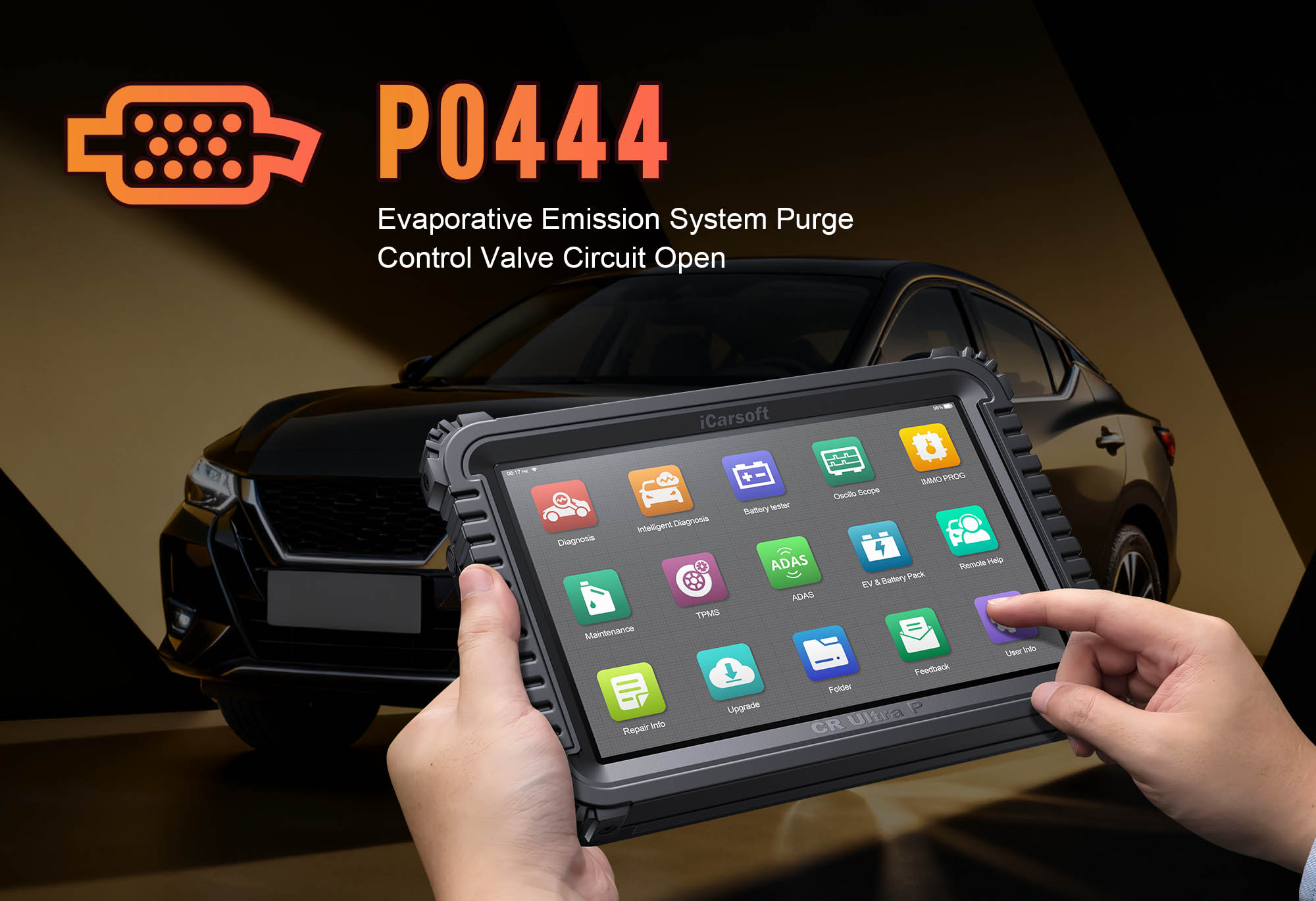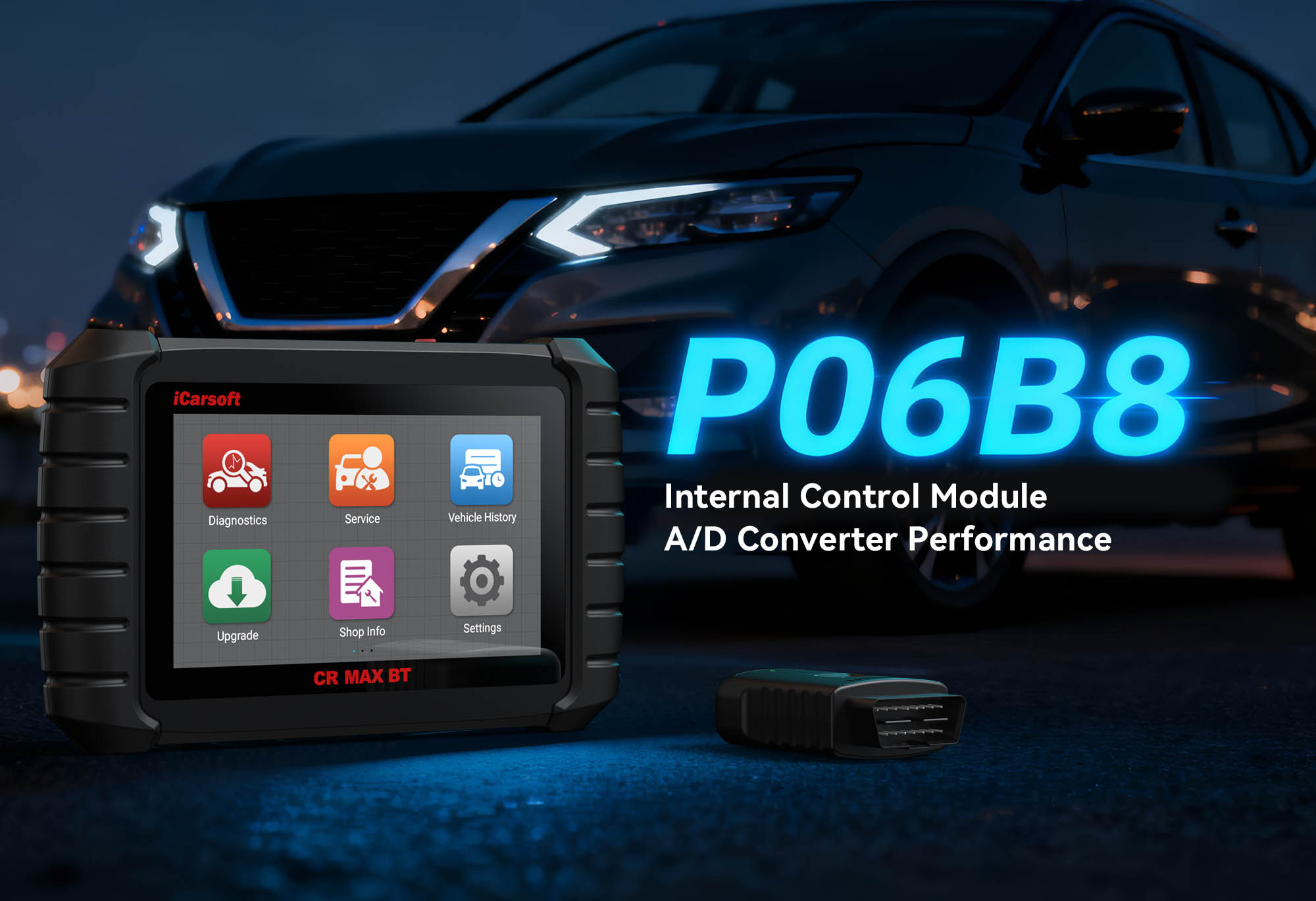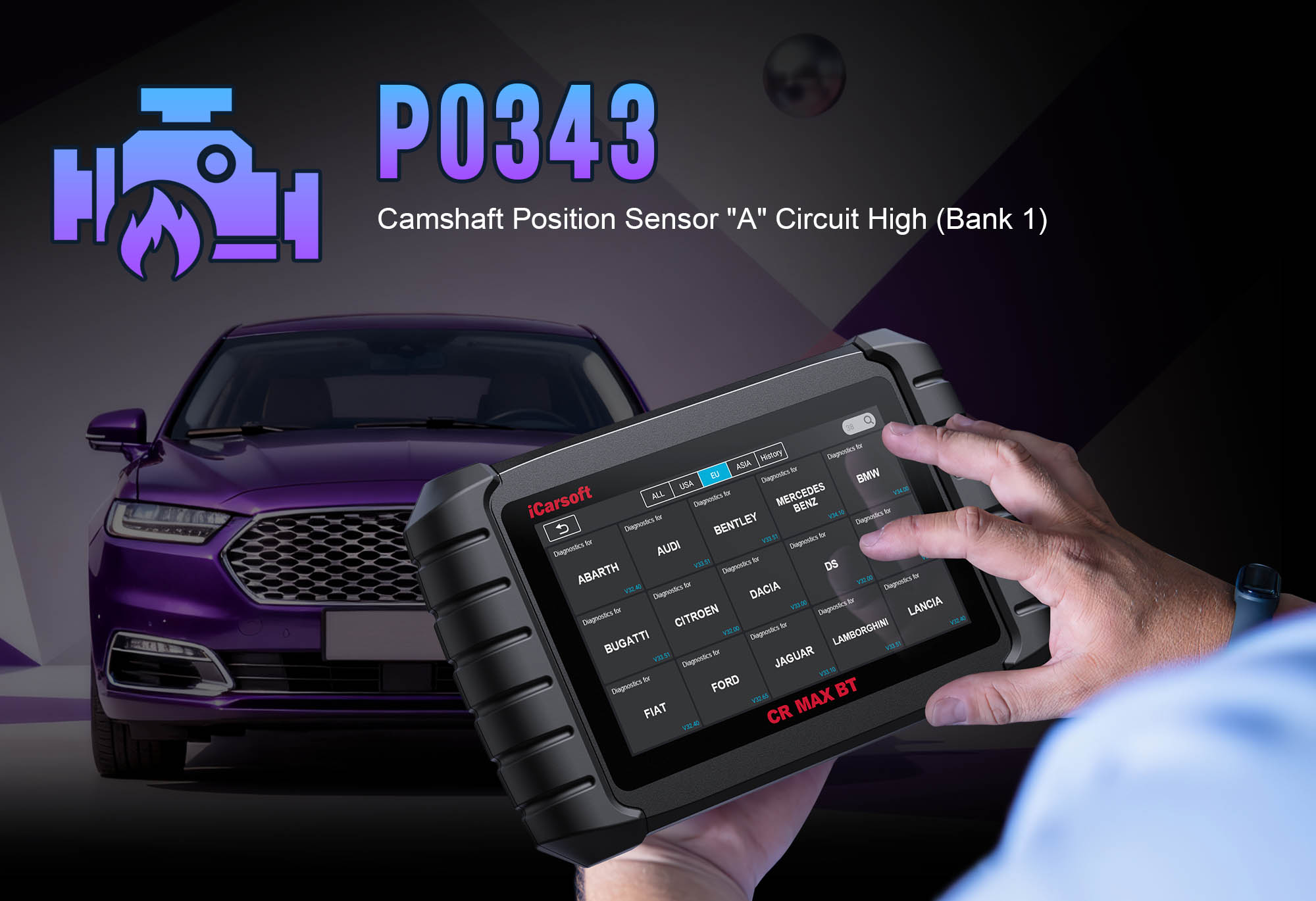Diagnose & Clear P0444 with iCarsoft CR Ultra P
If your vehicle’s check engine light stays on and you notice poor fuel efficiency or a faint gasoline odor, a diagnostic scan will likely return P0444. This OBD-II code stands for "Evaporative Emission Control System (EVAP) Vent Valve/Solenoid Circuit Open"—a fault targeting the electrical circuit of the EVAP vent valve (also called a solenoid) in your vehicle’s emissions system. The vent valve regulates airflow into the EVAP system, which captures and recycles fuel vapors from the gas tank to prevent harmful emissions. When the circuit powering this valve fails (e.g., due to a broken wire or faulty solenoid), the valve can’t open or close, disrupting pressure control and triggering P0444.
Basic scanners might only flag a "vent valve issue" but can’t test circuit continuity, verify solenoid functionality, or isolate wiring faults—leaving you guessing between a bad valve, corroded connector, or blown fuse. The iCarsoft CR Ultra P, with its advanced EVAP system diagnostics, bi-directional controls, and circuit topology mapping, solves this. Let’s break down how to diagnose and resolve P0444 with precision, using the CR Ultra P’s unique features to restore EVAP system integrity and emissions compliance.
Understanding P0444: Causes & Key Symptoms
The EVAP vent valve is typically mounted near the charcoal canister (under the vehicle or in the engine bay) and is controlled by the Engine Control Module (ECM). It opens to allow fresh air into the system during normal operation and closes during leak tests (when the ECM pressurizes the system to check for vapor leaks). P0444 triggers when the ECM detects no electrical current in the vent valve circuit—meaning the valve can’t respond to commands, leaving the system either stuck open (unable to hold pressure) or stuck closed (trapping vapors). As the fault persists, symptoms escalate:
Key Symptoms of P0444
-
Steady Check Engine Light (CEL): A persistent CEL is the primary indicator, often paired with "EVAP Vent Valve Circuit Open" messages.
-
Poor Fuel Economy: Unregulated vapor flow disrupts the ECM’s fuel trim adjustments, reducing mileage by 5–10%.
-
Fuel Odors: Trapped vapors or leaks may cause a faint gasoline smell near the rear of the vehicle (where the canister/vent valve are located).
-
Failed Emissions Tests: The EVAP system can’t pass leak tests, leading to high hydrocarbon readings and inspection failures.
-
Vapor Canister Damage: A stuck-closed valve may overpressurize the canister, causing cracks or internal damage over time.
Common Causes of P0444
|
Cause
|
Description
|
|
Faulty EVAP Vent Valve/Solenoid
|
Internal coil failure breaks the circuit, preventing the valve from opening/closing—common after 80,000–120,000 miles.
|
|
Damaged Wiring
|
Frayed wires, rodent chew marks, or corrosion (from water/road debris) in the vent valve harness create an open circuit.
|
|
Loose/Corroded Connector
|
The valve’s 2–3 pin connector becomes loose, rusted, or contaminated, disrupting current flow.
|
|
Blown Fuse
|
A dedicated fuse (7.5A–15A) powers the vent valve circuit; failure cuts power entirely, triggering P0444.
|
|
ECM Malfunction
|
Rarely, the ECM’s internal driver for the vent valve fails, unable to send voltage signals to the circuit.
|
Why iCarsoft CR Ultra P Excels at Diagnosing P0444
The CR Ultra P outperforms basic tools with features tailored to EVAP system and circuit diagnostics—critical for resolving P0444 accurately:
EVAP System Topology Mapping
Visualizes the entire EVAP circuit as a color-coded diagram, highlighting open circuits or faulty components at a glance.
Bi-Directional Vent Valve Control
Sends commands to open/close the valve, verifying responsiveness—distinguishing faulty valves from wiring/ECM issues.
Circuit Continuity & Voltage Testing
Built-in multimeter measures resistance/voltage/current, isolating breaks or shorts without guesswork.
Global Vehicle Coverage
Supports 200+ brands and EVAP system types (pressure/vacuum-based), including hybrid models.
CR Link VCI Compatibility
Works with modern protocols (DoIP, CAN-FD), compatible with 2018+ vehicles basic scanners miss.
41 Hot Service Functions
Includes EVAP leak tests, vent valve calibration, and ECM reset—critical for post-repair validation.
Battery & Circuit Health Checks
Built-in battery tests rule out low voltage (a common cause of false circuit faults) before diagnostics.
Step-by-Step: Diagnose P0444 with iCarsoft CR Ultra P
-
Safety First & Initial Visual Inspection
1. Keep engine off and avoid open flames (fuel vapors are flammable).
2. Locate components via Component Location > Emissions > EVAP System:
- EVAP Vent Valve: Near charcoal canister (rear of vehicle/engine bay).
- Vent Valve Fuse: Engine bay/interior fuse box (labeled "EVAP Vent").
- Wiring Harness: Loom connecting valve to ECM.
3. Visual Checks:
- Clean vent valve connector with contact cleaner; inspect for bent pins/rust.
- Follow wiring for frays/cuts/rodent damage.
- Test fuse with Voltage Test—no voltage = blown fuse (replace with same amperage).
-
Connect Tool & Confirm P0444
Plug CR Ultra P into OBD-II port, pair with CR Link VCI. Select AutoVIN Identify to retrieve specs. Navigate to Engine > Fault Codes > Read Codes to confirm P0444. Tap Code Details for vehicle-specific insights (e.g., "Toyota RAV4: Voltage 0V, Expected 12V"). Check related codes (P0440, P0445) and resolve P0444 first.
-
Use Topology Mapping to Identify the Fault
Navigate to Engine > Topology Mapping > Emissions > EVAP Vent Circuit. Review the color-coded diagram:
- Green: Functional components (intact wire, good fuse, responsive valve).
- Red: Faulty components (open wire, blown fuse, unresponsive valve).
Note red-marked areas to target further testing.
-
Test Vent Valve Circuit & Solenoid Function
1. Vent Valve Resistance Test: Disconnect valve, multimeter Ohms—20–30 ohms (varies by make); infinite resistance (>100 ohms) = open coil (replace).
2. Circuit Voltage Test: Reconnect connector, ignition "ON" (no start). Monitor Engine > Live Data > EVAP > Vent Valve Circuit: Power wire = 11.5–12.5V (0V = fuse/wire fault); control signal fluctuates 0V–12V (no fluctuation = ECM issue).
3. Bi-Directional Activation: Use Special Functions > Emissions > EVAP Vent Valve Control—activate "Open/Close"; listen for "clicks" (no click = faulty valve/circuit).
-
Repair or Replace Faulty Components
- Fuse Replacement: Install OEM-spec fuse (e.g., 10A); replace again if it blows (check for shorted valve/wiring).
- Wiring Repairs: Splice damaged wires with 18-gauge automotive wire + heat-shrink; replace corroded connector pigtails + dielectric grease.
- Vent Valve Replacement: Remove old valve (1–2 bolts), disconnect vacuum line; install OEM-equivalent (e.g., Dorman 911-088); torque to 8–10 ft-lbs, reconnect lines/connector.
- ECM Reset: Use Special Functions > Engine > ECU Reset for temporary faults; consult authorized service for permanent failures.
-
Clear P0444 & Validate the Repair
1. Clear Code: Navigate to Engine > Fault Codes > Clear Codes—confirm P0444 deletion.
2. EVAP System Test: Run Special Functions > Emissions > EVAP Leak Test—"No Leak Detected" = fix confirmed.
3. Test Drive & I/M Readiness: Drive 50–100 miles (cold starts, highway speeds); use I/M Readiness to confirm EVAP monitor is "Ready."
4. Save Report: Document fault/repairs/post-repair data via History & Report.
Preventing P0444 Recurrence
-
Regular Vent Valve Checks: Use Service Reminder to test valve resistance/activation every 30,000 miles—catch early coil wear.
-
Wiring Inspections: Check harness every 15,000 miles for rodent damage/corrosion—use topology map for hard-to-reach areas.
-
Fuse Maintenance: Inspect vent valve fuse during oil changes—replace proactively every 50,000 miles.
-
3 Years of Free Updates: Use One-Key Upgrade to add advanced EVAP diagnostic features (e.g., valve wear tracking).
Conclusion
P0444’s EVAP vent valve circuit open may seem minor, but it risks failed emissions tests, fuel waste, and canister damage. The iCarsoft CR Ultra P simplifies diagnosis with topology mapping, bi-directional controls, and circuit tests, ensuring you fix the exact fault (valve, wiring, fuse) instead of guessing.
With its 200+ brand coverage, CR Link VCI, and 41 service functions, the CR Ultra P is more than a P0444 fix—it’s a long-term investment in keeping your emissions system efficient. Pass inspections, reduce fuel costs, and protect the environment—all with one professional-grade diagnostic tool.





